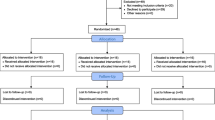Abstract
The number of patients with juvenile-onset Sjögren’s syndrome (SS) has recently increased. However, there is no drug that is safe and effective for the xerostomia that occurs in patients of this age group. We evaluated the efficacy and safety of orally administered pilocarpine hydrochloride for juvenile-onset SS patients. Five female patients, aged from 9 to 16 years, received 5–10 mg/day for 4 weeks. On days 1 and 28, salivary production was measured by the Saxon test, and patients completed subjective self-evaluations of xerostomia symptoms and were asked about changes in water intake and overall improvement of dry mouth on day 28. After 4 weeks of pilocarpine administration, salivary production increased significantly in all patients, and overall status was assessed as “improved” in all patients. One patient had excessive sweating. No serious adverse events or laboratory examination abnormalities correlated with pilocarpine administration were found. In conclusion, the results of this study suggest that orally administered pilocarpine is safe and effective for treating xerostomia in juvenile-onset SS patients. This is the first report of the efficacy of pilocarpine for juvenile SS patients; further evaluations are needed to confirm our result.



Similar content being viewed by others
References
Tomiita M, Saito K, Kohno Y, Shimojo N, Fujikawa S, Niimi H. The clinical features of Sjögren’s syndrome in Japanese children. Acta Paediatr Jpn. 1997;39:268–72.
Cimaz R, Casadei A, Rose C, Bartunkova J, Sediva A, Falcini F, et al. Primary Sjögren syndrome in paediatric age: a multicentre survey. Eur J Pediatr. 2003;162:661–5.
Singer NG, Tomaowa-Soltys I, Lowe R. Sjögren’s syndrome in childhood. Curr Rheumatol Rep. 2008;10:147–55.
Fujibayashi T, Sugai S, Miyasaka N, Hayashi Y, Tsubota K. Revised Japanese criteria for Sjögren’s syndrome (1999): availability and validity. Mod Rheumatol. 2004;14:425–34.
Taylor P. Cholinergic agonists. In: Gilman AG, Rall TW, Nies AS, Taylor P, editors. Goodman and Gilman’s the pharmacological basis of therapeutics. 8th ed. New York: Pergamon Press; 2004. p. 122–30.
Naito Y, Matsumoto I, Wakamatsu E, et al. Muscarinic acetylcholine receptor autoantibodies in patients with Sjögren’s syndrome. Ann Rheum Dis. 2005;64:510–1.
Nakamura Y, Wakamatsu E, Matsumoto I, et al. High prevalence of autoantibodies to muscarinic-3 acetylcholine receptor in patients with juvenile-onset Sjögren syndrome. Ann Rheum Dis. 2008;67:136–7.
Jorkjend L, Bergenholtz A, Johansson AK, et al. Effect of pilocarpine on impaired salivary secretion in patients with Sjögren’s syndrome. Swed Dent J. 2008;32:49–56.
Rosas J, Ramos-Casals M, Ena J, et al. Usefulness of basal and pilocarpine-stimulated salivary flow in primary Sjögren’s syndrome. Correlation with clinical, immunological and histological features. Rheumatology. 2002;41:670–5.
Peluso G, De Santis M, Inzitari R, et al. Proteomic study of salivary peptides and proteins in patients with Sjögren’s syndrome before and after pilocarpine treatment. Arthritis Rheum. 2007;56:2216–22.
Papas AS, Sherrer YS, Charney M, et al. Successful treatment of dry mouth and dry eye symptoms in Sjögren’s syndrome patients with oral pilocarpine: a randomized, placebo-controlled, dose-adjustment study. J Clin Rheumatol. 2004;10:169–77.
Kuar A, Singla V, Khokhar S, et al. Efficacy of oral pilocarpine in patients with Sjögren’s syndrome. Indian J Rheumatol. 2006;1:93–8.
Sugai S, Koike T, Miyasaka N, et al. Dose-finding study of oral pilocarpine for the treatment of xerostomia associated with Sjögren’s syndrome. Jpn Pharmacol Ther. 2007;35:s141–53.
Konno A, Nishio M, Origasa H. Oral pilocarpine for radiation-induced xerostomia: a randomized, double-blind, placebo-controlled trial. Jpn Pharmacol Ther. 2007;35:s131–9.
Conflict of interest statement
None.
Author information
Authors and Affiliations
Corresponding author
About this article
Cite this article
Tomiita, M., Takei, S., Kuwada, N. et al. Efficacy and safety of orally administered pilocarpine hydrochloride for patients with juvenile-onset Sjögren’s syndrome. Mod Rheumatol 20, 486–490 (2010). https://doi.org/10.1007/s10165-010-0313-7
Received:
Accepted:
Published:
Issue Date:
DOI: https://doi.org/10.1007/s10165-010-0313-7




